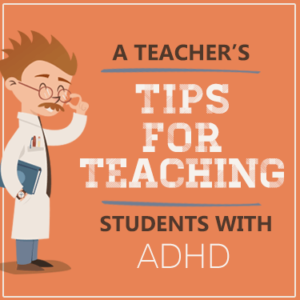Do you have a student in your classroom who has been diagnosed with ADHD? If so, you may be wondering how to teach students with ADHD in order to best help them succeed in school. It can be a challenge, but with the right strategies in place, it is definitely possible. In this blog post, we will provide you with everything you need to know that how to teach students with ADHD. We’ll discuss the symptoms of ADHD, as well as some helpful strategies for accommodating these students in your classroom. Let’s get started!
Contents
Students With ADHD

ADHD is known as Attention Deficit Hyperactivity Disorder (ADHD), or sometimes it is called ADD where the “hyperactivity” part is absent.
People with ADHD show symptoms of inattention when they are at a young age. It is believed that ADHD is caused by low levels of dopamine and norepinephrine in the brain.
Many countries also recognize it as a mental disorder, but its exact causes are unknown. It’s believed to be genetic or environmental.
Three Symptoms Of ADHD

Specifically, there are three symptoms. However, these symptoms may vary in intensity. It is a combination of inattention, hyperactivity, and impulsiveness that is usually diagnosed;
Inattention
This is defined as difficulty in paying attention to details and making careless mistakes in schoolwork or other activities. Difficulty sustaining attention during tasks or play activities. Difficulty listening when spoken to directly. Excessive talking, blurting out answers before questions have been completed, difficulty waiting for a turn or in line.
Hyperactivity
The child or teen fidgets, squirms in the seat, has difficulty remaining still. Feeling restless, often running or climbing excessively. Unable to engage in leisure activities quietly. The person acts before thinking about what the outcome may be which can cause problems while social interactions.
Impulsiveness
The child has difficulty resisting temptations or delaying gratification. They may interrupt others, grab things from other people, or speak out of turn. These behaviors can lead to social problems with peers.
How ADHD Affects Learning
ADHD affects learning both mentally and physically. Mentally because when students with ADHD get distracted by others or something else it makes them ADHD is a family disease. Parents need to be fully aware of the condition, its challenges, and its symptoms so that they can take appropriate measures for their children’s management.
Successful ADHD Treatment Plan
Here are the three main components of a successful ADHD treatment plan:
-Behavior modification therapy. This type of therapy helps students learn how to control their impulses and stay focused on tasks.
-Medication. Most students with ADHD are prescribed medication to help them stay calm.
-Education and support. It is important for both the student and their parents to have access to educational resources and support groups.
How To Teach Students With ADHD
The best way to teach a student with ADHD is by modifying teaching styles. It is crucial to know that ADHD affects the brain’s frontal cortex and causes impulsivity in those who have it.
The way we approach these students can either make or break their learning experience, so here are some tips to teach students with ADHD:
– Breaking tasks down into small, manageable steps can help students with ADHD stay on track.
– Use verbal cues and visual aids to keep students focused in class. Allow for movement and breaks throughout the day, as restless energy is common among those with ADHD.
– Be consistent with rules and expectations, and provide clear instructions to avoid confusion. Encourage students to focus on the task at hand.
– Group work is a great way to teach students with ADHD, as they can receive constant feedback and are less likely to lose interest.
– Provide opportunities for physical activity during class time, such as taking a nature walk or doing yoga.
– Using a timer to ensure that students stay on track while studying. Giving frequent breaks during lessons is necessary to keep the lesson interesting and to increase productivity.
– Positive reinforcement will help students feel good about themselves and their progress. So, celebrating successes is important no matter it is big or small.
Teaching students with ADHD can be a challenge, but it is definitely worth it! These tips are sure to help you create a successful learning environment for your student. Remember to always be patient.
There are many more ways that teachers can help their students with ADHD, but these tips are the most important.
Teaching Techniques

Teaching techniques that work well with students who have ADHD include a format.
-Start by introducing the material in a clear and concise way.
-Break the material down into small, manageable steps. This will help students to stay on track.
-Begin the lesson through direct instruction with a short, high-interest activity that focuses the student’s attention.
– Conducting the lesson using easy methods of presentation, such as charts, models, and multimedia aids.
– Providing a lot of verbal support and feedback throughout the lesson. Pausing frequently to give students time to respond orally.
– Ending the lesson with a review and summarizing the key points covered.
Other Things To Focus Upon While Teaching
– Having a predictable, structured routine environment. Breaking tasks down into small, manageable steps can also help.
– Using visual aids, such as pictures, diagrams, or videos to help explain concepts.
– Keeping rules and expectations consistent, and providing clear instructions to avoid confusion. Encouraging students to focus on the task
– When possible, reward desired behavior instead of punishing undesired behaviors.
– Give the student options in assignments and projects whenever feasible.
Helping Children with ADHD

Children with ADHD need structure and support in order to thrive in school, home, social interactions, and other settings. Some children have difficulty focusing on things they do not like, but if the activity is interesting enough, they can concentrate for hours.
Teachers’ Role and Cooperation
The school plays an important role in the management and planning of children with ADHD. It is necessary that teachers:
• Work collaboratively with parents to develop concrete, consistent, long-term goals for students.
• Provide clear instructions on how to complete tasks. For example, if you want the student to turn in homework, specify what type of assignment it is, when it is due, and how it should be formatted.
• Be aware of potential triggers for ADHD symptoms (for example, loud noises or a chaotic environment) and avoid them if possible.
• Reward positive behavior consistently.
As a teacher, there are few things to pay attention to when it comes to students with ADHD.
•One must listen carefully before acting on what you hear from others about the student’s behavior in class or at home.
• It is important to take time for a one-to-one conversation with each child rather than talking only during group meetings.
• The teacher has to be patient while making interactions with students.
Each student with ADHD is different, so what works for one may not work for another.
Parents’ Role
Students who have attention deficit hyperactivity disorder usually require more parental support as compared to their peers. In addition, they also need a different kind of help than what other children with learning or emotional issues get from their parents.
Parents’ role in helping children is more efficient because they know their children the best. Parents can teach their children to follow simple instructions, how to behave and interact in social situations, and develop a sense of responsibility by themselves.
Tips for parents to help their children with ADHD are:
– establish rules and limits; make sure these are clear, consistent, and fair.
– keep a daily routine as much as possible; this will help your child feel more in control and understand what is expected of them.
– provide positive reinforcement when your child follows through with expectations; offer praise and rewards, such as a favorite activity or privilege, when they display good behavior.
* learn about ADHD from reliable sources like doctors and educational therapists; this helps them to understand the challenges their child faces in school or at home.
* seek help from professionals like therapists, counselors, and doctors to get advice on how best to deal with ADHD.
* cooperate with the school teachers; they can be a valuable source of support in helping your child succeed in school.
Conclusion
Teaching students with ADHD can be very challenging. It is important to have a positive attitude and not let the challenges get you down. By following the tips in this article, you will be well on your way to becoming an effective teacher of students with ADHD. It is not easy, but it will be worth it in the end!
A Word From Therapy Mantra
Your mental health — Your psychological, emotional, and social well-being — has an impact on every aspect of your life. Positive mental health essentially allows you to effectively deal with life’s everyday challenges.
At TherapyMantra, we have a team of therapists who provide affordable online therapy to assist you with issues such as depression, anxiety, stress, workplace Issues, addiction, relationship, OCD, LGBTQ, and PTSD. You can book a free therapy or download our free Android or iOS app.


